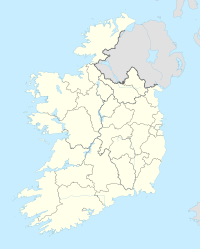Wicklow Mountains National Park
The Wicklow Mountains National Park ( Irish Páirc Náisiúnta Shléibhte Chill Mhantáin , English Wicklow Mountains National Park ) is one of the six national parks in the Republic of Ireland (see map). It was designated in its current size of around 200 km² in 1991. It lies in the heart of the Wicklow Mountains in County Wicklow in eastern Ireland, which were largely formed in the Paleozoic during the Caledonian Folding , with a visitor center at Glendalough , which can be translated as "Valley of the Two Lakes". The cluster of 6th century monastery ruins on Lower Lake is one of the most famous on the island. As early as the 6th century, a partially paved path led through Glendalough (Wicklow - Glendalough - Dunlavin). There are numerous church and monastery ruins, crosses and churches on this so-called St. Kevin's Road.
Bullauns
Derrybawn ( Doire Bán ) is one of the numerous bullauns . It stands south of St. Kevin's Church at the foot of Derrybawn Mountain ( Sliabh Dhoire Bán ), next to the Glenealo River. The portlaun is known locally as the "Deer Stone". The granite stone has a conical basin and curved sides.
Burnt Mounds
The Burnt Mound of Ballinabrocky ( Buaile na Brocaí ) on the western edge of the park stands out among the numerous "Fulachta Fia" . It's at the southeast end of a small valley and typically by a stream that flows into the Liffey . The crescent-shaped hill has an inner area of 10 m × 5 m.
The caher
The archaeological monument is adjacent to Upper Lake. It is a stone ring fort with a dry stone wall about 20 m in diameter, which has a remaining height of about one meter. Cahers are regionally referred to as Cathair, Cashel or Dun and depending on their location, shape or material they are also known as Cliff, Coastal, Promontory , Ring or Steinfort. Similar facilities can be found all over the island. The original purpose of the systems and the exact time of their manufacture are not known. The mostly round systems are dated to the Bronze or Iron Ages. The Glendalough Caher was later believed to have been used as a station (stopping point for prayers) for pilgrims to the ruins of St. Kevin's Monastery.
Cup brands
Camaderry is an example of bowls discovered in 1877 at the base of the Camaderry Mountains on a mica schist rock near the eastern end of Upper Lake. The stone with 18 "cups" was later moved to the monastery complex.
Megaliths
The megalithic complexes are located in the northwest of the park around the Seefin Mountains and Sorrel Hill. The mountains Seefin, Seefingan and Seahan are crowned by Cairns from 10 to over 20 m in diameter and three meters in height and by passage tombs . Among the menhirs, those of glass bullets (at the holy spring) and clay pebbles stand out.
Reefert Church
The remains of Reefert Church ( Teampall Rífhearta ) are located in a wooded area on the south-eastern shore of Upper Lake. The name Reefert is derived from the Irish 'Righ Fhearta' "Tombs of the Kings" (based on the local O'Toole clan). The church dates from the 11th century and may have been built on the site of an older church. The church and cemetery were originally surrounded by an early church enclosure in the form of a wall. Most of the current walls are modern. The upper parts were renewed with the original stones over 100 years ago.
St. Kevin's Bed
St. Kevin's Bed is a tiny cave whose entrance is about eight meters above the lake, in a rock wall east of Templenaskellig. The cave is only two meters deep and was believed to be a retreat for St. Kevin and later for St. Laurence O'Toole.
St. Kevin's Cell
The foundations of a small beehive hut , the typical accommodation for early Christian monks, lie on a spur above Upper Lake.
Template cellular
The ruins of the small church Templenaskellig ( Teampall na Sceilge ) lie at the foot of the cliffs on the southern shore of Upper Lake. To the west of the church is a platform with the remains of round huts. The church was renovated in the 12th century.
Different crosses
There are several stone crosses on Upper Lake , which may also have been used as stations during the pilgrimage to Glendalough.
Nearby
Parts of the Powerscourt estate also belong to the national park . Powerscourt Castle is just outside the national park.
Web links
Coordinates: 53 ° 0 ′ 37 ″ N , 6 ° 19 ′ 39 ″ W.




